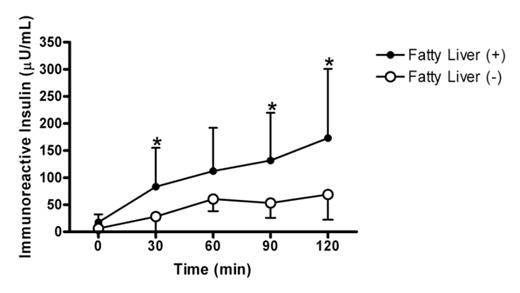Abstract
[Introduction] An increasing number of long-term surviving stem cell transplantation (SCT) recipients have recovered from their primary disease but are at risk of developing failure of endocrine organs. Among the complications that have been described following SCT, metabolic syndrome (MS) has occurred in long-term survivors. Mechanism of MS as the late complication, however, is not completely elucidated.
[Patients & Methods] We investigated 52 recipients (30 males and 22 females) who underwent SCT during childhood or adolescence. The median age at SCT was 10.5 years (range 0.9–15.9 years), and the median follow-up duration after SCT was 15.0 years (range 6.7–24.7 years). Obesity was evaluated by analyzing changes in body mass index (BMI) and abdominal circumference. Lipid and glucose profiles were evaluated by the presence of fatty liver (hepatic steatosis), TG, T-Chol, HDL-C, LDL-C, adiponectine, leptin and HOMA-R, 75g OGTT, respectively.
[Results] 11 males (37%) and 11 females (50%) were diagnosed as fatty liver by abdominal ultrasound and computed tomography and biopsy was performed in selected patients. However only one male recipient satisfied MS criteria in all recipients. Among the 52 recipients, 9 males (30%) and 15 females (68%) indicated under 18.5 kg/m2 of BMI, whereas recipients with over 25 kg/m2 of BMI were two males and one female. The levels of TG and T-Chol were significantly higher in recipients with fatty liver compared to recipients without fatty liver (TG: 111mg/dL, range 49–751 vs 78, 41–219, p <0.05, TC; 213mg/dL, 166–294 vs 175, 82–250, p <0.05). In addition, the level of leptin was significantly increased in recipients with fatty liver compared to recipients without fatty liver (male: 9.9ng/mL, 2.4–20.8 vs 4.2, 1.9–10.4, p <0.05, female: 18.0, 5.6–25.6 vs 7.9, 3.3–13.2, p <0.05, respectively). On the other hand, the level of adiponectin was significantly decreased in recipients with fatty liver compared to recipients without fatty liver (male: 4.8 μg/mL, 2.6–8.9 vs 8.5, 5.0–29.5, p <0.001, female: 4.1, 2.1–18.5 vs 11.4, 7.1–19.7, p <0.05, respectively). The level of HOMA-R was significantly increased in recipients with fatty liver compared to recipients without fatty liver (2.3, 0.5–12.3 vs 1.2, 0.6–3.7, p <0.05, respectively). Moreover, 75g OGTT indicated that insulin resistance significantly appeared in recipients with fatty liver.
[Conclusion] These investigations emphasize the need of for long-term follow-up of endocrine and metabolic profiles in adult survivors of childhood SCT recipients.
Author notes
Disclosure: No relevant conflicts of interest to declare.


This feature is available to Subscribers Only
Sign In or Create an Account Close Modal